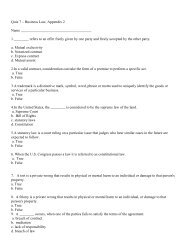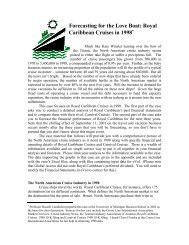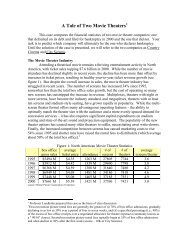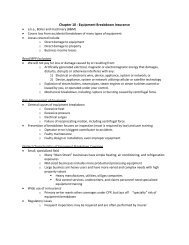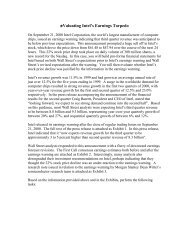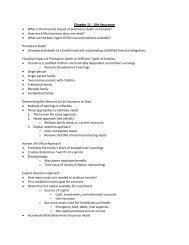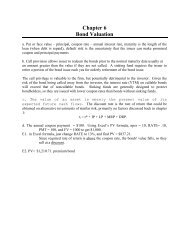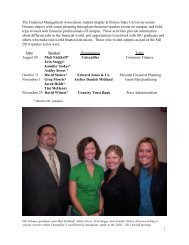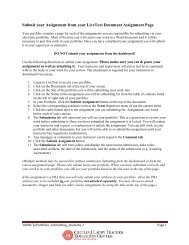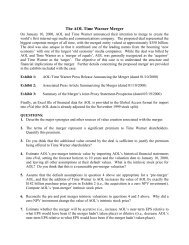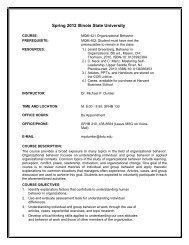Final Exam Review Sheet - Illinois State University
Final Exam Review Sheet - Illinois State University
Final Exam Review Sheet - Illinois State University
You also want an ePaper? Increase the reach of your titles
YUMPU automatically turns print PDFs into web optimized ePapers that Google loves.
DEPARTMENT OF FINANCE, INSURANCE & LAW<br />
COLLEGE OF BUSINESS<br />
ILLINOIS STATE UNIVERSITY<br />
FIL 350 – Property Insurance<br />
<strong>Final</strong> <strong>Exam</strong> <strong>Review</strong> <strong>Sheet</strong><br />
Chapter 1 – Introduction to Commercial Property Insurance<br />
Risk management concepts<br />
What are four types of loss exposures faced by business organizations?<br />
What are the steps of the risk management process?<br />
What are four categories of loss exposures for businesses?<br />
Policy formats<br />
What is the difference between multiline and monoline policies?<br />
What are the benefits of a CPP when compared to buying many individual monoline coverages?<br />
Common policy conditions<br />
What are the six conditions included in the common policy conditions form?<br />
Determine the actual cash value of a loss.<br />
Determine the coinsurance penalty faced by policyholder that does not have adequate insurance to<br />
value.<br />
Other definitions<br />
Loss exposure, avoidance, risk control, loss prevention, loss reduction, separation, commercial package<br />
policy (CPP), multiline policy, monoline policy, standard form, non standard form<br />
Chapter 2 – Building and Personal Property Coverage Form<br />
<br />
<br />
<br />
<br />
<br />
<br />
What forms are required to be combined to provide property insurance coverage under a CPP?<br />
What are the three major categories of property covered by BPP? What is considered part of the<br />
building? What are the categories of personal property?<br />
What are three major categories of property not covered?<br />
What are the six additional coverages and six coverage extensions included in the BPP?<br />
What optional coverages are described in the BPP coverage form?<br />
What is the valuation basis for improvements and betterments?<br />
Definitions<br />
Declarations page, Fixture, bailee, FLARE perils
Chapter 3 – Causes of Loss Forms<br />
What are the three available causes of loss forms? What differentiates these forms?<br />
What perils are covered under the causes of loss – basic form?<br />
What exclusions are listed in all causes of loss forms (see page 3.16)?<br />
Definitions<br />
Concurrent causation doctrine, voluntary parting, unauthorized instructions<br />
Chapter 4 – Commercial Property Coverage Options<br />
<br />
<br />
<br />
What are the advantages and disadvantages of blanket insurance over specific insurance?<br />
How does the value reporting form affect the amount of coverage for a policyholder?<br />
o How are the premium and coverage limits determined for the value reporting form?<br />
o What penalties apply if a policyholder misses a report?<br />
Define and recognize the potential use of each of the following endorsements:<br />
o Manufacturers selling price, functional building or personal property valuation, peak season<br />
limit of insurance, manufacturers consequential loss, brands and labels, ordinance or law<br />
coverage endorsement, spoilage coverage<br />
Chapter 5 – Condo forms and builders risk<br />
<br />
<br />
<br />
<br />
What are common elements? What is the split of property between condo unit owners and<br />
associations? How does this differ under the bare walls, single entity (original specs), and all-in<br />
concepts?<br />
How are the unit owners coverage and association coverage coordinated?<br />
What are methods of covering builders’ risks?<br />
List the additional coverages and extensions under the builders risk form.<br />
Definitions<br />
Highly protected risk, owner controlled insurance program (OCIP), standard property policy (SPP)<br />
Chapter 6 – Flood, earthquake, and specialty forms<br />
<br />
<br />
<br />
<br />
What are the objectives in National Flood Insurance Program?<br />
What are the four coverages in the NFIP general property form?<br />
What are the differences between NFIP and the ISO flood endorsement?<br />
How<br />
Definitions<br />
Special flood hazard area (SFHA), ensuing losses, difference in conditions insurance, output policy
Chapter 7 – Business Income Insurance<br />
<br />
<br />
<br />
<br />
<br />
<br />
<br />
How are business income losses calculated?<br />
What are the five required elements that define coverage for business income losses?<br />
How does a business determine the limit of insurance and coinsurance amount for business income?<br />
What is the coinsurance basis for business income insurance? What are ways to reduce the<br />
coinsurance basis? What are some approaches used to avoid coinsurance penalty under the<br />
business income coverage form?<br />
What are three categories of extra expenses incurred by businesses during a shutdown?<br />
What are the additional coverages and extension included in business income coverage form?<br />
Define and recognize the potential use of each of the following business income endorsements:<br />
o Dependent property exposures<br />
Definitions<br />
Civil authority, expected maximum loss, period of restoration, extended business income, contributing<br />
location, recipient location, leader location, manufacturing location<br />
Chapter 8 – Inland Marine and Ocean Cargo<br />
<br />
<br />
<br />
<br />
What are the major categories of loss exposures under marine insurance?<br />
Which parties are involved in transportation loss exposures?<br />
Identify the major forms of ocean marine insurance including hull insurance and P&I?<br />
Define the common types of marine insurance such as annual transit vs. trip transit insurance, open<br />
cargo, and motor truck insurance.<br />
Chapter 9 – Commercial Crime Insurance<br />
<br />
<br />
<br />
<br />
<br />
Differentiate burglary, safe burglary, and robbery.<br />
What are the eight insuring agreements contained in the commercial crime coverage form? For<br />
each agreement, what are the covered causes of loss, covered property, and extensions?<br />
What are some additional insuring agreements available as endorsements to commercial crime<br />
forms?<br />
What are the exclusions that apply to all crime insuring agreements?<br />
Differentiate the loss sustained and discovery versions of crime insurance policies.<br />
Definitions<br />
Termination as to any employee, loss sustained under prior insurance, extended period of discovery
Chapter 10 – Equipment Breakdown Insurance<br />
<br />
<br />
<br />
What are the major types of equipment that are covered under equipment breakdown insurance?<br />
What is the need for equipment breakdown insurance? What is the insuring agreement?<br />
Define the ten available insuring agreements under the equipment breakdown coverage form?<br />
Definitions<br />
Fired pressure vessels<br />
Chapter 11 – Businessowners Policies (BOP)<br />
<br />
<br />
<br />
<br />
Who is the target audience for BOP?<br />
What are some types of eligibility rules for BOP?<br />
What lines of coverage are included in a BOP?<br />
What are the similarities and major differences between the BOP and the BPP + BI?<br />
Chapter 13 – Surety Bonds<br />
<br />
<br />
What is a surety bond? What are the similarities and differences between surety bonds and<br />
insurance?<br />
What are the major categories of surety bonds? What are the various types of contract bonds?<br />
Definitions<br />
Principle, obligee, surety, bid bond, performance bond, payment bond, maintenance bond, license and<br />
permit bonds, public official bonds, CT bonds, fiduciary bonds



